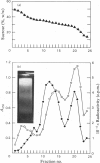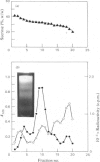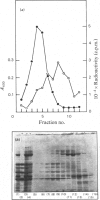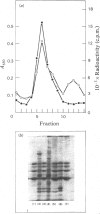Abstract
A rapid methof for preparation of membrane fractions highly enriched in nicotinic acetylcholine receptor from Torpedo californica electroplax is described. The major step in this purification involves sucrose-density-gradient centrifugation in a reorienting rotor. Further purification of these membranes can be achieved by selective extraction of proteins by use of alkaline pH or by treatment with solutions of lithium di-idosalicylate. The alkali-treated membranes retain functional characteristics of the untreated membranes and in addition contain essentially only the four polypeptides (mol.wts. 40000, 50000, 60000 and 65000) characteristic of the receptor purified by affinity chromatography. Dissolution of the purified membranes or of the alkali-treated purified membranes in sodium cholate solution followed by sucrose-density-gradient centrifugation in the same detergent solution yields solubilized receptor preparations comparable with the most highly purified protein obtained by affinity-chromatographic procedures.
Full text
PDF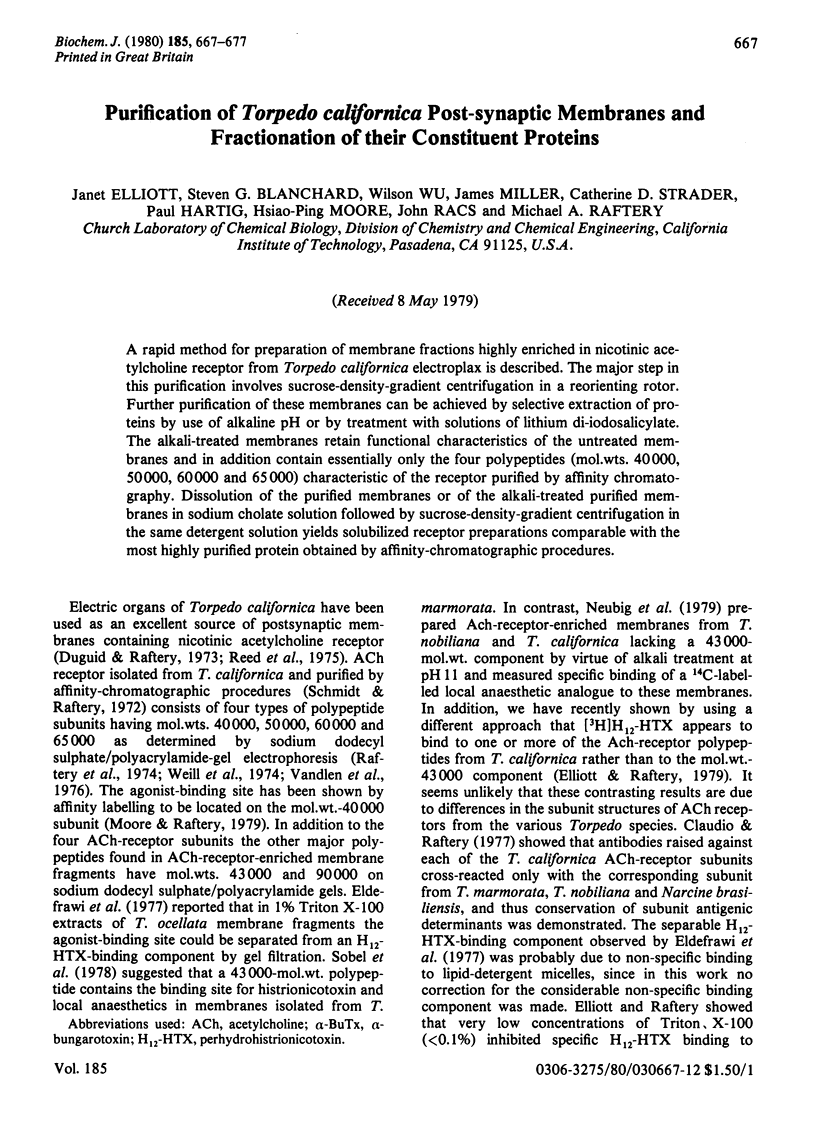
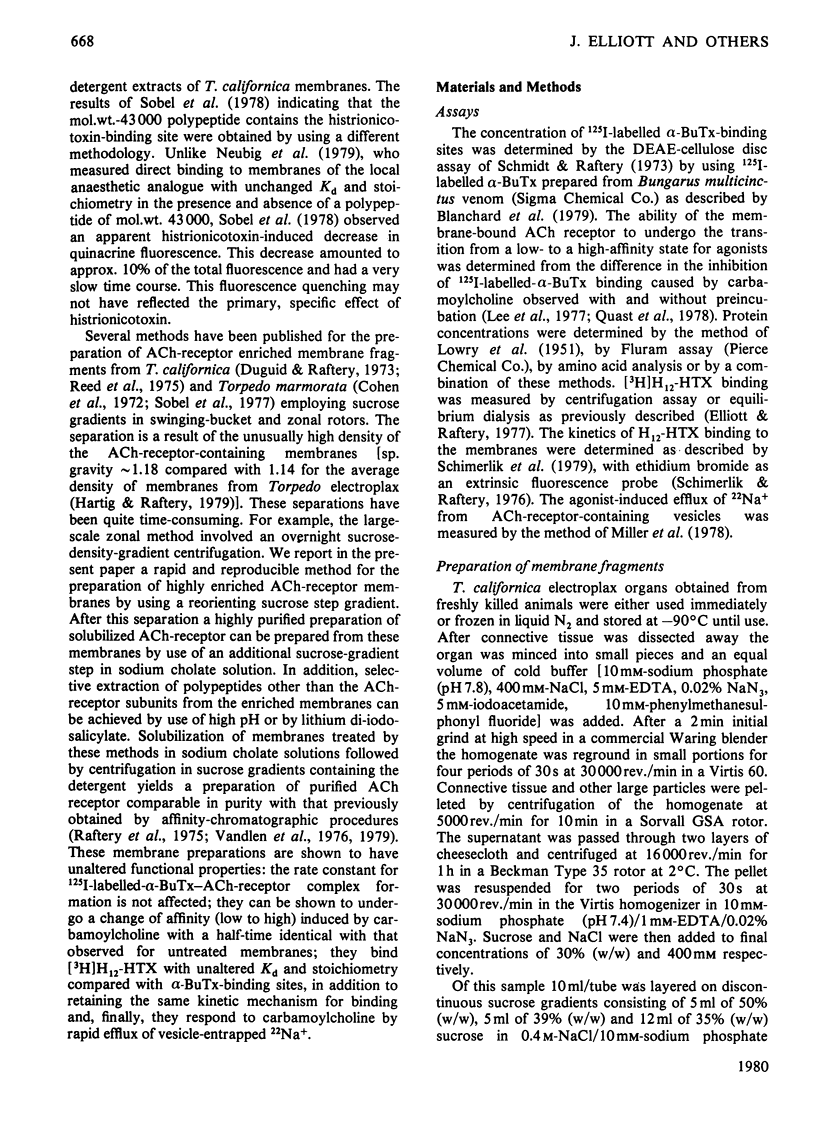
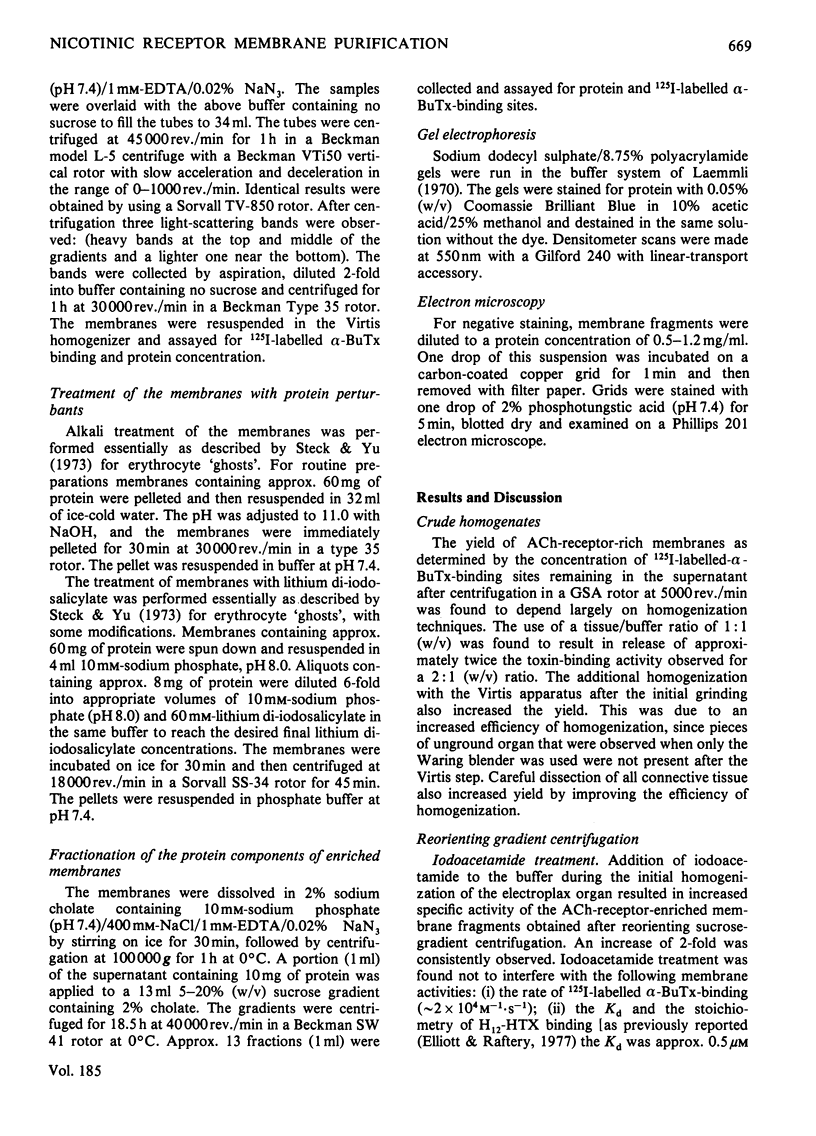
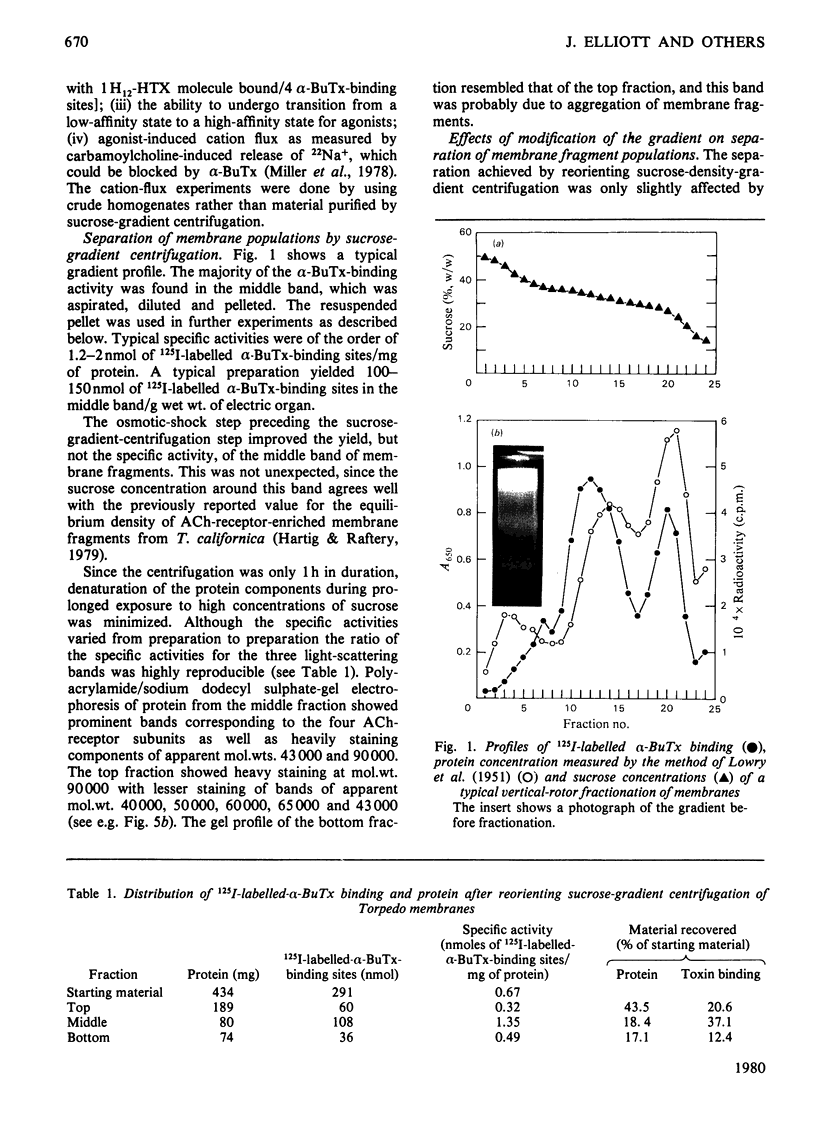
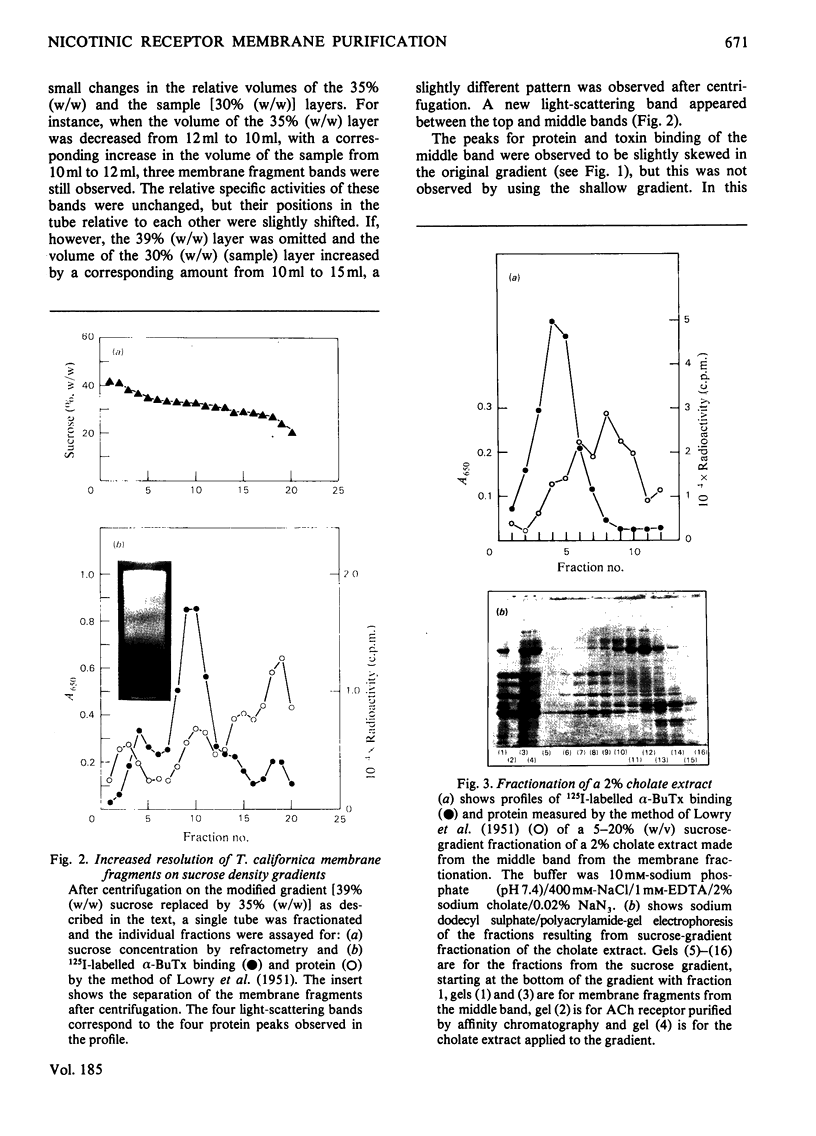
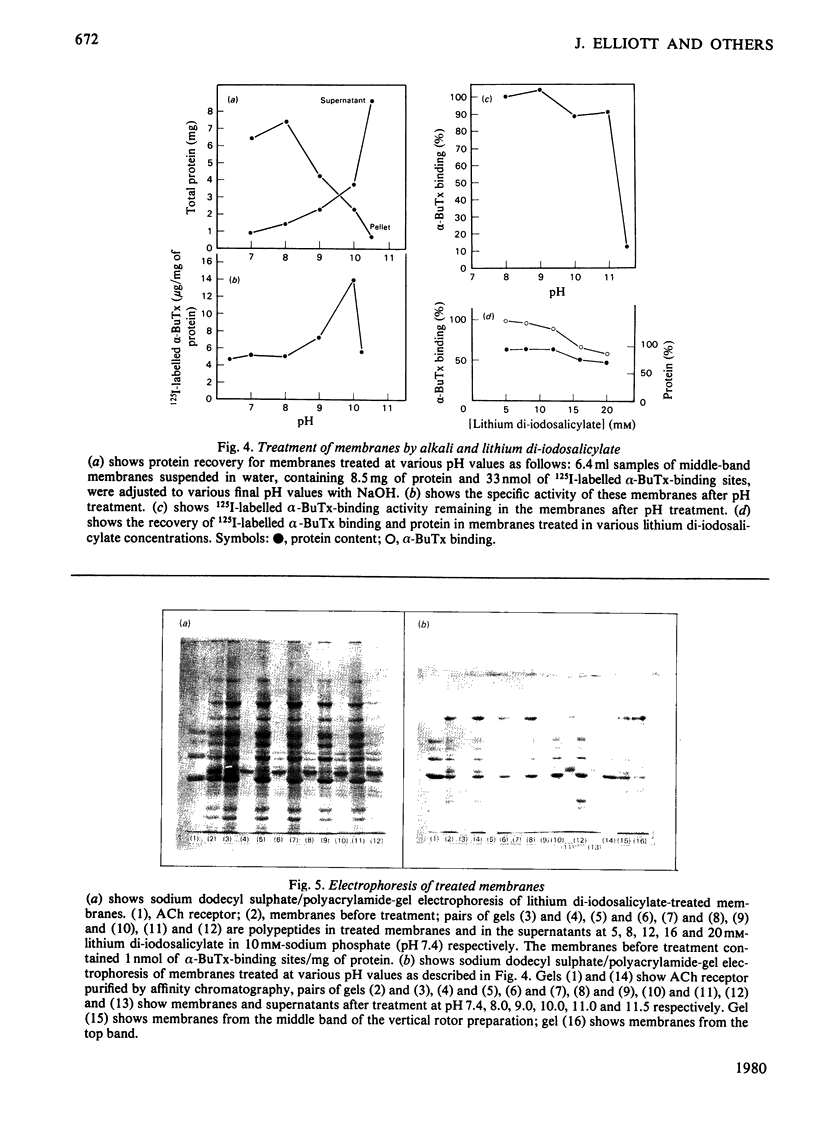
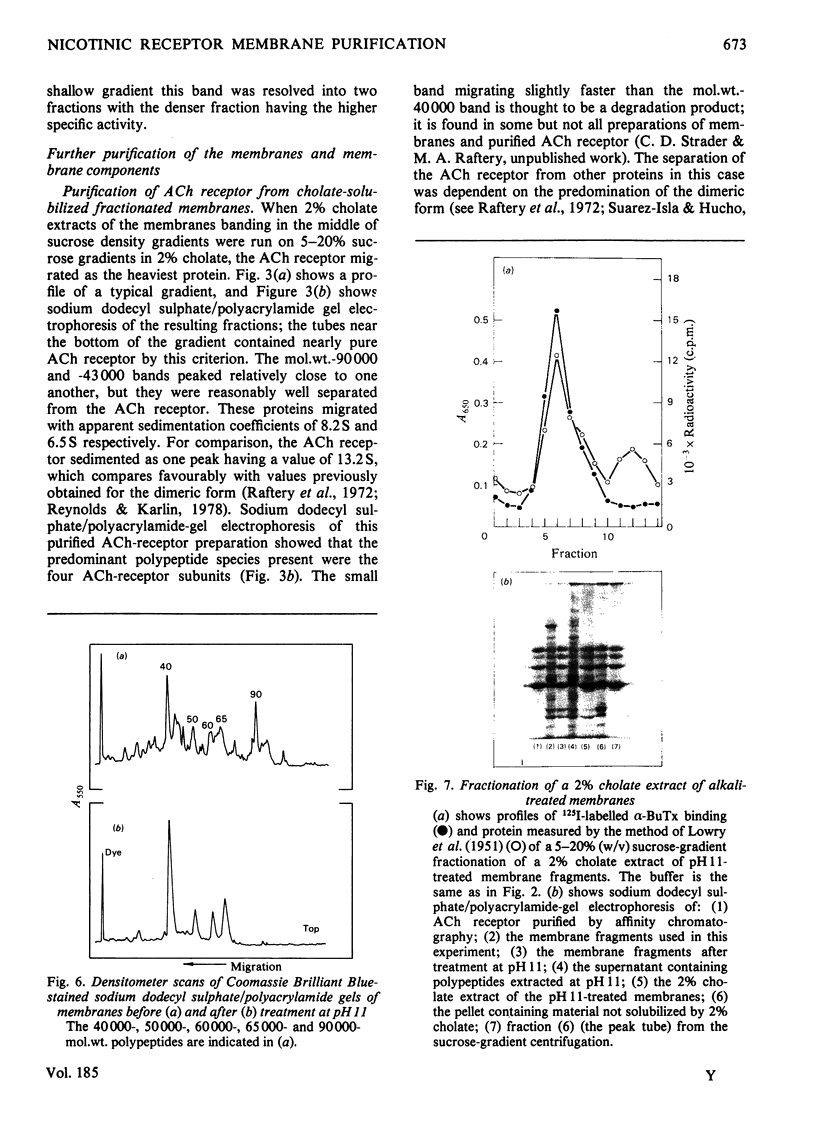
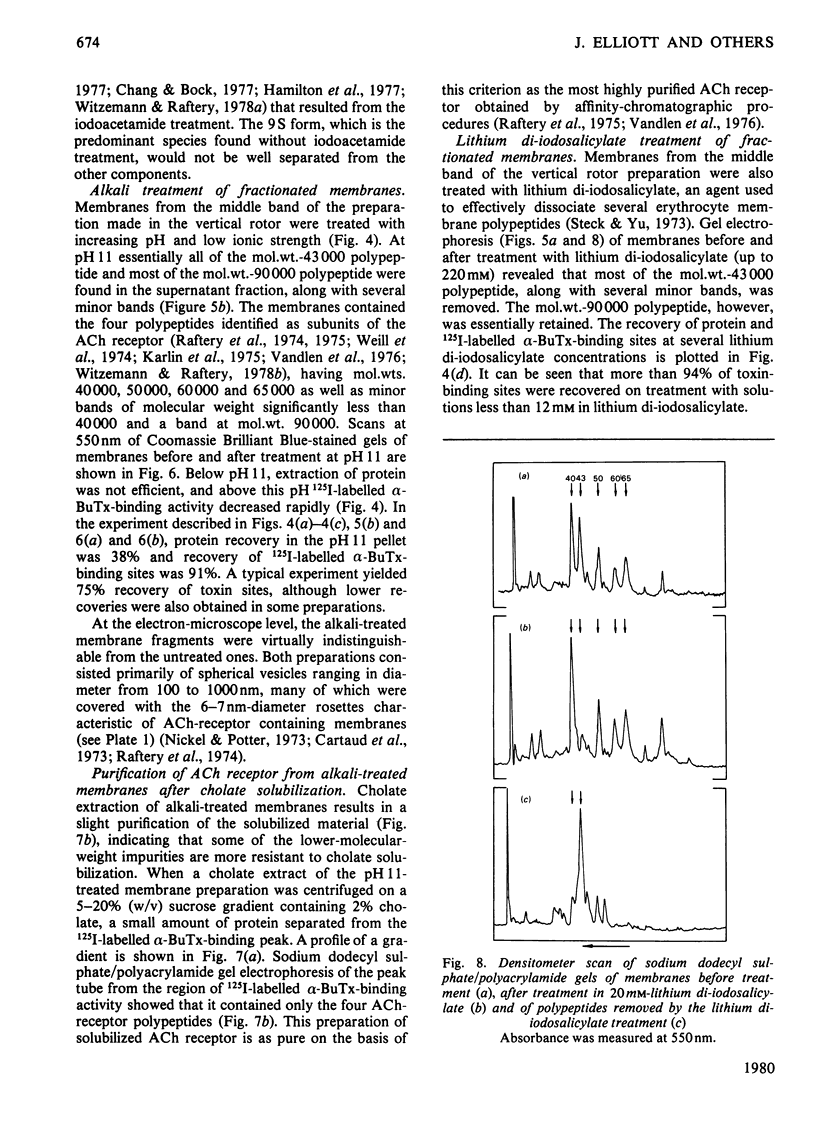
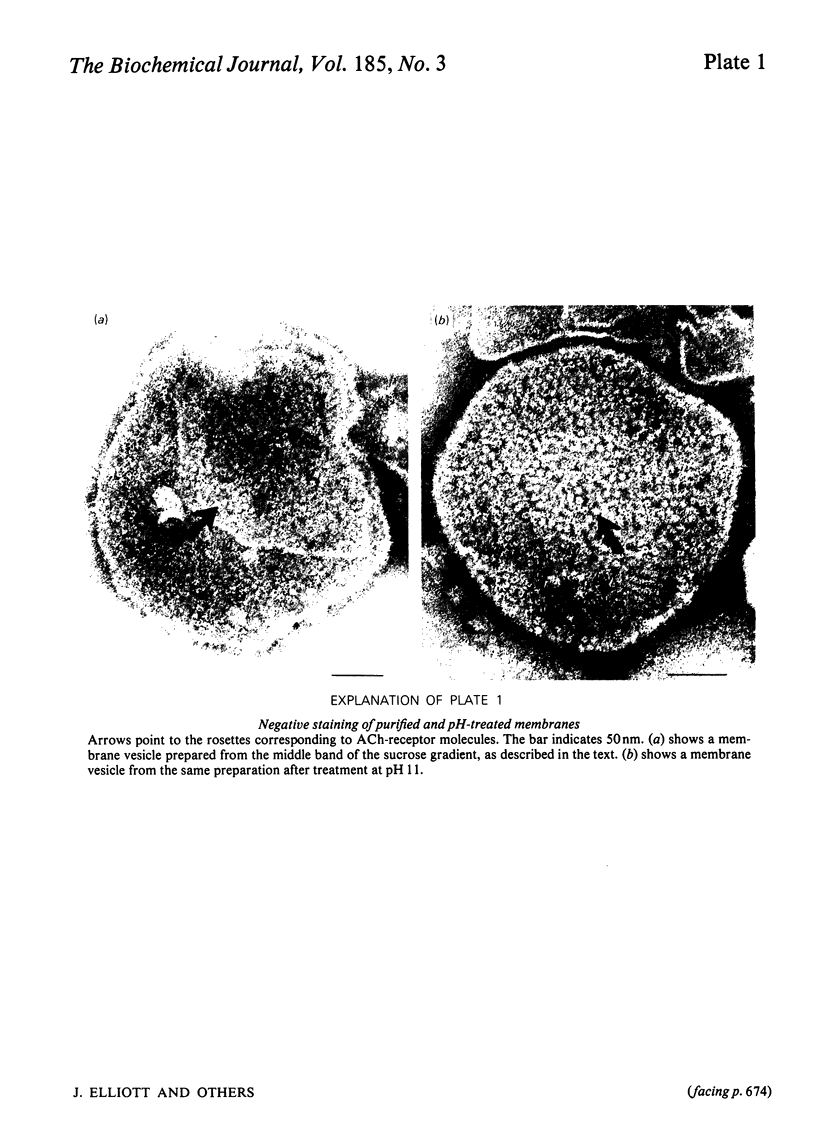

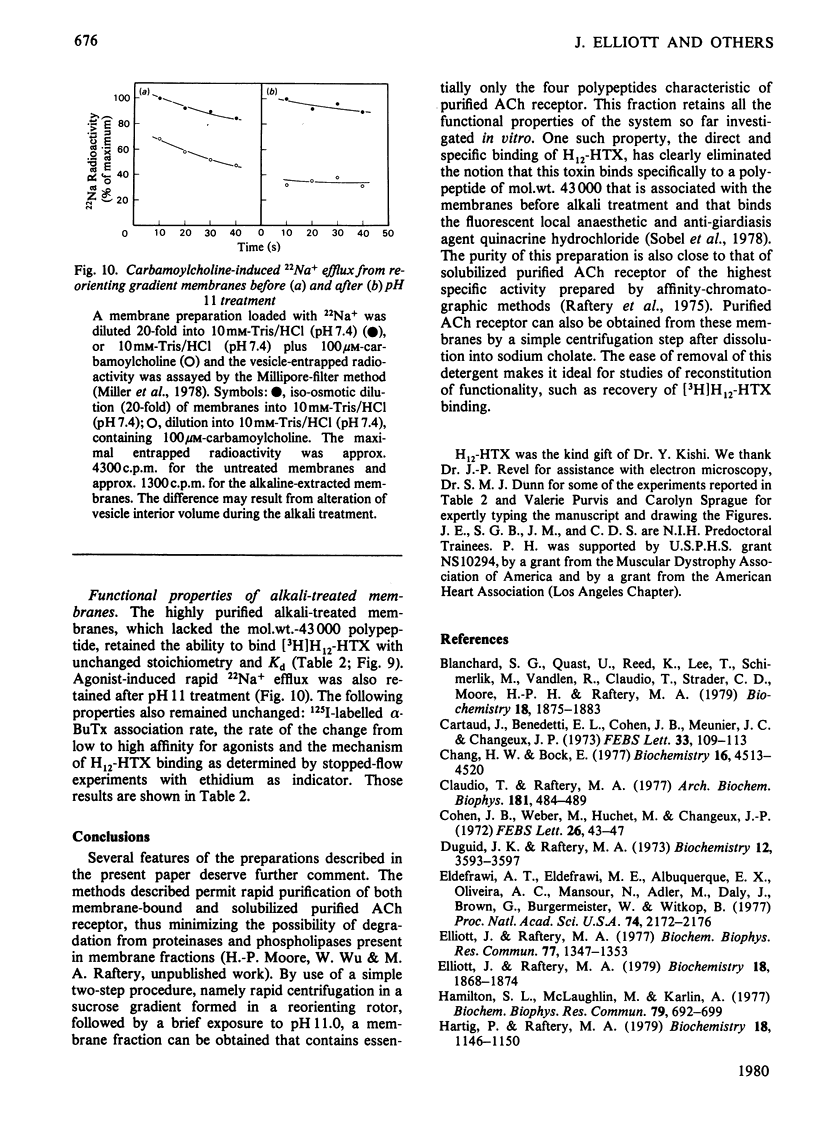
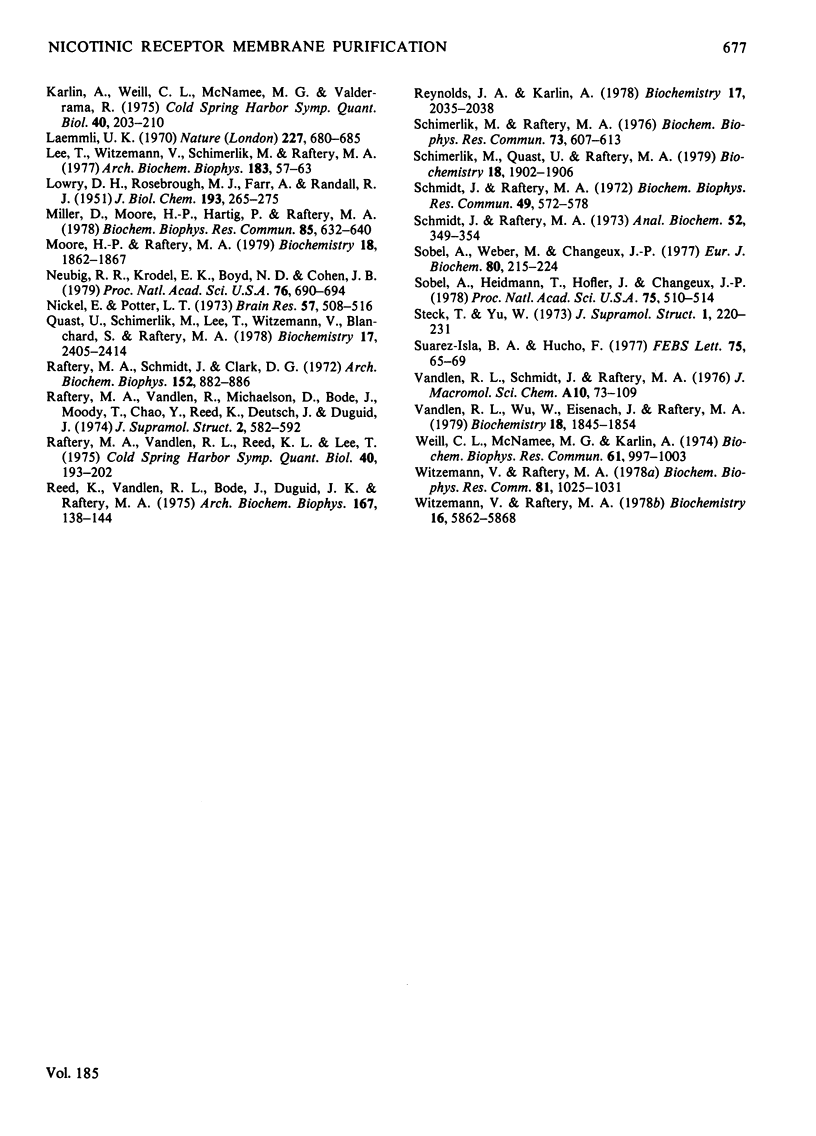
Images in this article
Selected References
These references are in PubMed. This may not be the complete list of references from this article.
- Blanchard S. G., Quast U., Reed K., Lee T., Schimerlik M. I., Vandlen R., Claudio T., Strader C. D., Moore H. P., Raftery M. A. Interaction of [125I]-alpha-bungarotoxin with acetylcholine receptor from Torpedo californica. Biochemistry. 1979 May 15;18(10):1875–1883. doi: 10.1021/bi00577a005. [DOI] [PubMed] [Google Scholar]
- Cartaud J., Benedetti E. L., Cohen J. B., Meunier J. C., Changeux J. P. Presence of a lattice structure in membrane fragments rich in nicotinic receptor protein from the electric organ of Torpedo marmorata. FEBS Lett. 1973 Jun 15;33(1):109–113. doi: 10.1016/0014-5793(73)80171-1. [DOI] [PubMed] [Google Scholar]
- Chang H. W., Bock E. Molecular forms of acetylcholine receptor. Effects of calcium ions and a sulfhydryl reagent on the occurrence of oligomers. Biochemistry. 1977 Oct 4;16(20):4513–4520. doi: 10.1021/bi00639a028. [DOI] [PubMed] [Google Scholar]
- Claudio T., Raftery M. A. Immunological comparison of acetylcholine receptors and their subunits from species of electric ray. Arch Biochem Biophys. 1977 Jun;181(2):484–489. doi: 10.1016/0003-9861(77)90254-5. [DOI] [PubMed] [Google Scholar]
- Cohen J. B., Weber M., Huchet M., Changeux J. P. Purification from Torpedo marmorata electric tissue of membrane fragments particularly rich in cholinergic receptor protein. FEBS Lett. 1972 Oct 1;26(1):43–47. doi: 10.1016/0014-5793(72)80538-6. [DOI] [PubMed] [Google Scholar]
- Duguid J. R., Raftery M. A. Fractionation and partial characterization of membrane particles from Torpedo californica electroplax. Biochemistry. 1973 Sep 11;12(19):3593–3597. doi: 10.1021/bi00743a003. [DOI] [PubMed] [Google Scholar]
- Eldefrawi A. T., Eldefrawi M. E., Albuquerque E. X., Oliveira A. C., Mansour N., Adler M., Daly J. W., Brown G. B., Burgermeister W., Witkop B. Perhydrohistrionicotoxin: a potential ligand for the ion conductance modulator of the acetylcholine receptor. Proc Natl Acad Sci U S A. 1977 May;74(5):2172–2176. doi: 10.1073/pnas.74.5.2172. [DOI] [PMC free article] [PubMed] [Google Scholar]
- Elliot J., Raftery M. A. Interactions of perhydrohistrionicotoxin with postsynaptic membranes. Biochem Biophys Res Commun. 1977 Aug 22;77(4):1347–1353. doi: 10.1016/s0006-291x(77)80127-7. [DOI] [PubMed] [Google Scholar]
- Elliott J., Raftery M. A. Binding of perhydrohistrionicotoxin to intact and detergent-solubilized membranes enriched in nicotinic acetylcholine receptor. Biochemistry. 1979 May 15;18(10):1868–1874. doi: 10.1021/bi00577a004. [DOI] [PubMed] [Google Scholar]
- Hamilton S. L., McLaughlin M., Karlin A. Disulfide bond cross-linked dimer in acetylcholine receptor from Torpedo californica. Biochem Biophys Res Commun. 1977 Dec 7;79(3):692–699. doi: 10.1016/0006-291x(77)91167-6. [DOI] [PubMed] [Google Scholar]
- Hartig P. R., Raftery M. A. Preparation of right-side-out, acetylcholine receptor enriched intact vesicles from Torpedo californica electroplaque membranes. Biochemistry. 1979 Apr 3;18(7):1146–1150. doi: 10.1021/bi00574a004. [DOI] [PubMed] [Google Scholar]
- Karlin A., Weill C. L., McNamee M. G., Valderrama R. Facets of the structures of acetylcholine receptors from Electrophorus and Torpedo. Cold Spring Harb Symp Quant Biol. 1976;40:203–210. doi: 10.1101/sqb.1976.040.01.022. [DOI] [PubMed] [Google Scholar]
- Laemmli U. K. Cleavage of structural proteins during the assembly of the head of bacteriophage T4. Nature. 1970 Aug 15;227(5259):680–685. doi: 10.1038/227680a0. [DOI] [PubMed] [Google Scholar]
- Lee T., Witzemann V., Schimerlik M., Raftery M. A. Cholinergic ligand-induced affinity changes in Torpedo californica acetylcholine receptor. Arch Biochem Biophys. 1977 Sep;183(1):57–63. doi: 10.1016/0003-9861(77)90418-0. [DOI] [PubMed] [Google Scholar]
- Miller D. L., Moore H. P., Hartig P. R., Raftery M. A. Fast cation flux from Torpedo californica membrane preparations: implications for a functional role for acetylcholine receptor dimers. Biochem Biophys Res Commun. 1978 Nov 29;85(2):632–640. doi: 10.1016/0006-291x(78)91209-3. [DOI] [PubMed] [Google Scholar]
- Moore H. P., Raftery M. A. Studies of reversible and irreversible interactions of an alkylating agonist with Torpedo californica acetylcholine receptor in membrane-bound and purified states. Biochemistry. 1979 May 15;18(10):1862–1867. doi: 10.1021/bi00577a003. [DOI] [PubMed] [Google Scholar]
- Neubig R. R., Krodel E. K., Boyd N. D., Cohen J. B. Acetylcholine and local anesthetic binding to Torpedo nicotinic postsynaptic membranes after removal of nonreceptor peptides. Proc Natl Acad Sci U S A. 1979 Feb;76(2):690–694. doi: 10.1073/pnas.76.2.690. [DOI] [PMC free article] [PubMed] [Google Scholar]
- Nickel E., Potter L. T. Ultrastructure of isolated membranes of Torpedo electric tissue. Brain Res. 1973 Jul 27;57(2):508–517. doi: 10.1016/0006-8993(73)90158-3. [DOI] [PubMed] [Google Scholar]
- Quast U., Schimerlik M., Lee T., Witzemann T. L., Blanchard S., Raftery M. A. Ligand-induced conformation changes in Torpedo californica membrane-bound acetylcholine receptor. Biochemistry. 1978 Jun 13;17(12):2405–2414. doi: 10.1021/bi00605a024. [DOI] [PubMed] [Google Scholar]
- Raftery M. A., Schmidt J., Clark D. G. Specificity of -bungarotoxin binding to Torpedo californica electroplax. Arch Biochem Biophys. 1972 Oct;152(2):882–886. doi: 10.1016/0003-9861(72)90285-8. [DOI] [PubMed] [Google Scholar]
- Raftery M. A., Vandlen R. L., Reed K. L., Lee T. Characterization of Torpedo californica acetylcholine receptor: its subunit composition and ligand-binding properties. Cold Spring Harb Symp Quant Biol. 1976;40:193–202. doi: 10.1101/sqb.1976.040.01.021. [DOI] [PubMed] [Google Scholar]
- Raftery M. A., Vandlen R., Michaelson D., Bode J., Moody T., Chao Y., Reed K., Deutsch J., Duguid J. The biochemistry of an acetylcholine receptor. J Supramol Struct. 1974;2(5-6):582–592. doi: 10.1002/jss.400020506. [DOI] [PubMed] [Google Scholar]
- Reed K., Vandlen R., Bode J., Duguid J., Raftery M. A. Characterization of acetylcholine receptor-rich and acetylcholinesterase-rich membrane particles from Torpedo californica electroplax. Arch Biochem Biophys. 1975 Mar;167(1):138–144. doi: 10.1016/0003-9861(75)90449-x. [DOI] [PubMed] [Google Scholar]
- Reynolds J. A., Karlin A. Molecular weight in detergent solution of acetylcholine receptor from Torpedo californica. Biochemistry. 1978 May 30;17(11):2035–2038. doi: 10.1021/bi00604a001. [DOI] [PubMed] [Google Scholar]
- Schimerlik M. I., Quast U., Raftery M. A. Ligand-induced changes in membrane-bound acetylcholine receptor observed by ethidium fluorescence. 3. Stopped-flow studies with histrionicotoxin. Biochemistry. 1979 May 15;18(10):1902–1906. doi: 10.1021/bi00577a008. [DOI] [PubMed] [Google Scholar]
- Schimerlik M., Raftery M. A. A fluorescence probe of acetylcholine receptor conformation and local anesthetic binding. Biochem Biophys Res Commun. 1976 Dec 6;73(3):607–613. doi: 10.1016/0006-291x(76)90853-6. [DOI] [PubMed] [Google Scholar]
- Schmidt J., Raftery M. A. A simple assay for the study of solubilized acetylcholine receptors. Anal Biochem. 1973 Apr;52(2):349–354. doi: 10.1016/0003-2697(73)90036-5. [DOI] [PubMed] [Google Scholar]
- Schmidt J., Raftery M. A. Use of affinity chromatography for acetylcholine receptor purification. Biochem Biophys Res Commun. 1972 Oct 17;49(2):572–578. doi: 10.1016/0006-291x(72)90449-4. [DOI] [PubMed] [Google Scholar]
- Sobel A., Heidmann T., Hofler J., Changeux J. P. Distinct protein components from Torpedo marmorata membranes carry the acetylcholine receptor site and the binding site for local anesthetics and histrionicotoxin. Proc Natl Acad Sci U S A. 1978 Jan;75(1):510–514. doi: 10.1073/pnas.75.1.510. [DOI] [PMC free article] [PubMed] [Google Scholar]
- Sobel A., Weber M., Changeux J. P. Large-scale purification of the acetylcholine-receptor protein in its membrane-bound and detergent-extracted forms from Torpedo marmorata electric organ. Eur J Biochem. 1977 Oct 17;80(1):215–224. doi: 10.1111/j.1432-1033.1977.tb11874.x. [DOI] [PubMed] [Google Scholar]
- Steck T. L., Yu J. Selective solubilization of proteins from red blood cell membranes by protein perturbants. J Supramol Struct. 1973;1(3):220–232. doi: 10.1002/jss.400010307. [DOI] [PubMed] [Google Scholar]
- Suarez-Isla B. A., Hucho F. Acetylcholine receptor: SH group reactivity as indicator of conformational changes and functional states. FEBS Lett. 1977 Mar 15;75(1):65–69. doi: 10.1016/0014-5793(77)80054-9. [DOI] [PubMed] [Google Scholar]
- Vandlen R. L., Wu W. C., Eisenach J. C., Raftery M. A. Studies of the composition of purified Torpedo californica acetylcholine receptor and of its subunits. Biochemistry. 1979 May 15;18(10):1845–1854. doi: 10.1021/bi00577a001. [DOI] [PubMed] [Google Scholar]
- Weill C. L., McNamee M. G., Karlin A. Affinity-labeling of purified acetylcholine receptor from Torpedo californica. Biochem Biophys Res Commun. 1974 Dec 11;61(3):997–1003. doi: 10.1016/0006-291x(74)90254-x. [DOI] [PubMed] [Google Scholar]
- Witzemann V., Raftery M. A. Selective photoaffinity labeling of acetylcholine receptor using a cholinergic analogue. Biochemistry. 1977 Dec 27;16(26):5862–5868. doi: 10.1021/bi00645a034. [DOI] [PubMed] [Google Scholar]
- Witzemann V., Raftery M. Specific molecular aggregates or Torpedo californica acetylcholine receptor. Biochem Biophys Res Commun. 1978 Apr 14;81(3):1025–1031. doi: 10.1016/0006-291x(78)91453-5. [DOI] [PubMed] [Google Scholar]



